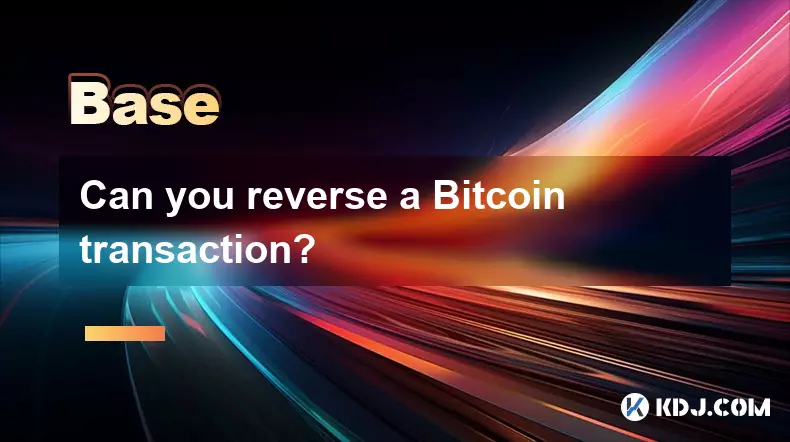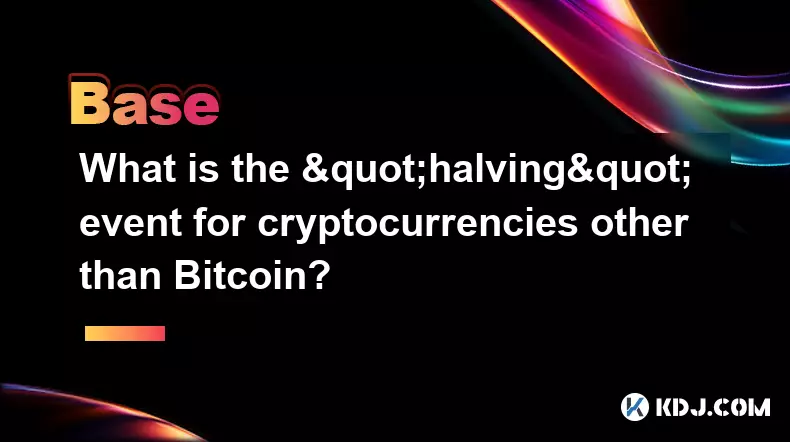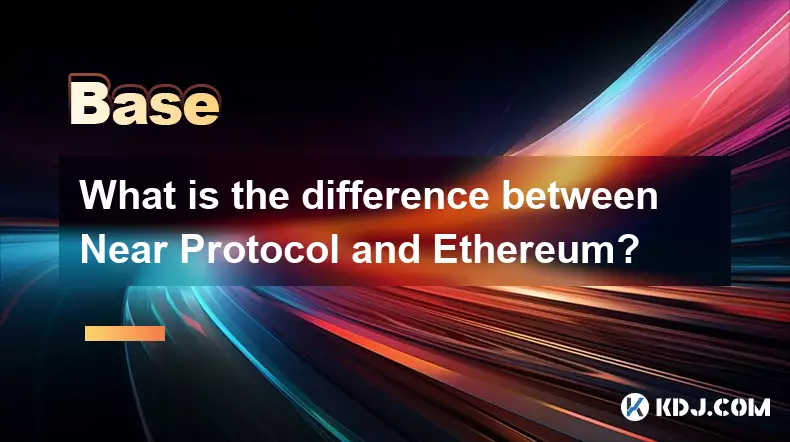-
 bitcoin
bitcoin $111743.690167 USD
0.54% -
 ethereum
ethereum $3950.699791 USD
0.55% -
 tether
tether $1.000164 USD
-0.01% -
 xrp
xrp $2.611685 USD
2.58% -
 bnb
bnb $1122.616845 USD
1.30% -
 solana
solana $193.462394 USD
-0.26% -
 usd-coin
usd-coin $0.999872 USD
-0.03% -
 dogecoin
dogecoin $0.196092 USD
-1.61% -
 tron
tron $0.296693 USD
-0.41% -
 cardano
cardano $0.652995 USD
-0.60% -
 hyperliquid
hyperliquid $44.316120 USD
12.98% -
 chainlink
chainlink $17.906269 USD
0.05% -
 ethena-usde
ethena-usde $0.999193 USD
-0.02% -
 stellar
stellar $0.326600 USD
1.70% -
 bitcoin-cash
bitcoin-cash $513.235984 USD
1.57%
Can you reverse a Bitcoin transaction?
Bitcoin transactions are irreversible once confirmed, secured by cryptography and network consensus, making fraud prevention and address verification essential.
Oct 20, 2025 at 09:36 pm

Understanding Bitcoin Transaction Mechanics
1. Bitcoin transactions are built on a decentralized ledger known as the blockchain, which records every transfer of value across the network. Once a transaction is confirmed and added to a block, it becomes part of an immutable chain. This design ensures transparency and security but also means that no central authority can alter or erase entries.
2. Each transaction consists of inputs and outputs, referencing previous transactions and directing funds to new addresses. These references are cryptographically secured, making tampering practically impossible without controlling the majority of the network’s computing power.
3. The irreversible nature of Bitcoin transactions is a foundational principle. Unlike traditional banking systems where chargebacks or reversals are possible, Bitcoin operates under a trustless model where users are solely responsible for verifying recipient addresses and transaction details before broadcasting.
4. Miners validate transactions by solving complex cryptographic puzzles, grouping them into blocks approximately every ten minutes. Once included in a block and followed by subsequent blocks, the likelihood of reversal diminishes exponentially due to the computational effort required to reorganize the chain.
5. Attempts to reverse a transaction would require executing a 51% attack, where an entity gains control over the majority of the network's hash rate. Such an event is highly improbable given the scale and distribution of mining operations globally, rendering successful reversals effectively unfeasible.
Scenarios That Mimic Transaction Reversal
1. In cases where a transaction has not yet been confirmed, it remains in the mempool—waiting to be picked up by miners. During this period, if conflicting transactions with higher fees are broadcast, the original may be dropped from the network, creating the appearance of reversal.
2. Some wallets support Replace-By-Fee (RBF), allowing users to replace an unconfirmed transaction with another offering a higher fee. While not a true reversal, this mechanism helps accelerate stuck transactions and can cancel pending ones under specific conditions.
3. If both parties cooperate, a recipient can voluntarily return funds after receiving them. This is not a reversal of the original transaction but rather a new one initiated independently. Trust between counterparties plays a crucial role in such arrangements.
4. Fraudulent services or phishing attacks sometimes trick users into sending funds to malicious addresses. Once sent, these transactions cannot be undone, emphasizing the importance of verifying destinations and using secure practices like multi-signature wallets.
5. Exchanges and custodial platforms may offer internal reversal options for transactions conducted within their ecosystem. However, these are administrative actions confined to their databases and do not affect the underlying blockchain record.
The Role of Confirmation Depth
1. The number of confirmations a transaction has directly impacts its permanence. A single confirmation indicates inclusion in one block; each additional block layered on top increases the difficulty of altering the record.
2. Most services consider six confirmations sufficient to treat a transaction as final. At this depth, reversing it would necessitate rewriting six consecutive blocks, requiring astronomical computational resources and energy expenditure.
3. For high-value transfers, some institutions wait for more than six confirmations to minimize even theoretical risks. The time cost is justified by enhanced security against rare chain reorganizations.
4. Lightweight clients and mobile wallets often rely on fewer confirmations for usability, accepting a marginal increase in risk for faster user experience. This trade-off underscores the balance between security and efficiency.
5. Network congestion can delay confirmations, prolonging the window during which double-spending attempts might occur. Attackers could exploit this by broadcasting conflicting transactions, though success remains extremely limited in practice.
Frequently Asked Questions
Can a wallet provider reverse my Bitcoin transaction?No. Wallet providers do not have the authority to modify the blockchain. They serve as interfaces for signing and broadcasting transactions but cannot alter or cancel them once submitted to the network.
What happens if I send Bitcoin to the wrong address?
If the address is valid and the transaction confirms, the funds are permanently transferred. Recovery depends entirely on whether the recipient is willing to return them. There is no mechanism to reclaim mistakenly sent coins.
Is it possible for a transaction to disappear from the blockchain?
No confirmed transaction can vanish from the blockchain. In rare instances of chain reorganization, a transaction might be removed from a block and returned to the mempool, but this does not constitute erasure—it only changes its confirmation status temporarily.
Do zero-confirmation transactions pose a reversal risk?
Yes. Transactions without confirmations are vulnerable to double-spending until they are mined into a block. Merchants accepting zero-conf transactions expose themselves to potential loss if attackers broadcast competing versions with higher fees.
Disclaimer:info@kdj.com
The information provided is not trading advice. kdj.com does not assume any responsibility for any investments made based on the information provided in this article. Cryptocurrencies are highly volatile and it is highly recommended that you invest with caution after thorough research!
If you believe that the content used on this website infringes your copyright, please contact us immediately (info@kdj.com) and we will delete it promptly.
- Essex Post Office, 5p Coins, and King Charles: A Royal Mint Revelation!
- 2025-10-23 10:30:16
- Waymo's Newark Airport AV Tests: Alphabet's AI Gamble Pays Off?
- 2025-10-23 10:30:16
- King Charles 5p Coins: A Royal Flush in Your Pocket?
- 2025-10-23 10:35:18
- Solana, Crypto Advisory, and Forward Industries: A New York Minute on the Future of Finance
- 2025-10-23 08:51:22
- MAGACOIN: Ethereum Whales Dive into the Hottest Presale of 2025
- 2025-10-23 08:51:22
- Kadena's End of the Road? KDA Token Plummets Amid Project Abandonment
- 2025-10-23 08:55:34
Related knowledge

How do decentralized identity (DID) solutions work?
Oct 14,2025 at 11:36pm
Understanding Decentralized Identity in the Blockchain Ecosystem1. Decentralized identity (DID) solutions are built on blockchain networks, allowing i...

What is the "halving" event for cryptocurrencies other than Bitcoin?
Oct 25,2025 at 12:19pm
Decentralized Exchanges Gain Momentum in 20241. Decentralized exchanges (DEXs) have seen a surge in trading volume as users prioritize control over th...

What is the difference between Near Protocol and Ethereum?
Oct 15,2025 at 08:01am
Near Protocol and Ethereum: Core Architectural Differences1. Near Protocol operates on a sharded blockchain architecture known as Nightshade, which al...

What does it mean for code to be "open source" in crypto?
Oct 12,2025 at 01:54pm
Understanding Open Source in the Cryptocurrency Ecosystem1. In the context of cryptocurrency, open source refers to software whose code is publicly ac...

What is the purpose of a "testnet"?
Oct 12,2025 at 09:01am
Understanding the Role of Testnets in Blockchain Development1. A testnet serves as a parallel version of a blockchain network, designed specifically f...

How to avoid phishing scams in crypto?
Oct 13,2025 at 06:18pm
Understanding Common Crypto Phishing Tactics1. Cybercriminals frequently use fake websites that mirror legitimate crypto exchanges or wallet platforms...

How do decentralized identity (DID) solutions work?
Oct 14,2025 at 11:36pm
Understanding Decentralized Identity in the Blockchain Ecosystem1. Decentralized identity (DID) solutions are built on blockchain networks, allowing i...

What is the "halving" event for cryptocurrencies other than Bitcoin?
Oct 25,2025 at 12:19pm
Decentralized Exchanges Gain Momentum in 20241. Decentralized exchanges (DEXs) have seen a surge in trading volume as users prioritize control over th...

What is the difference between Near Protocol and Ethereum?
Oct 15,2025 at 08:01am
Near Protocol and Ethereum: Core Architectural Differences1. Near Protocol operates on a sharded blockchain architecture known as Nightshade, which al...

What does it mean for code to be "open source" in crypto?
Oct 12,2025 at 01:54pm
Understanding Open Source in the Cryptocurrency Ecosystem1. In the context of cryptocurrency, open source refers to software whose code is publicly ac...

What is the purpose of a "testnet"?
Oct 12,2025 at 09:01am
Understanding the Role of Testnets in Blockchain Development1. A testnet serves as a parallel version of a blockchain network, designed specifically f...

How to avoid phishing scams in crypto?
Oct 13,2025 at 06:18pm
Understanding Common Crypto Phishing Tactics1. Cybercriminals frequently use fake websites that mirror legitimate crypto exchanges or wallet platforms...
See all articles










































































